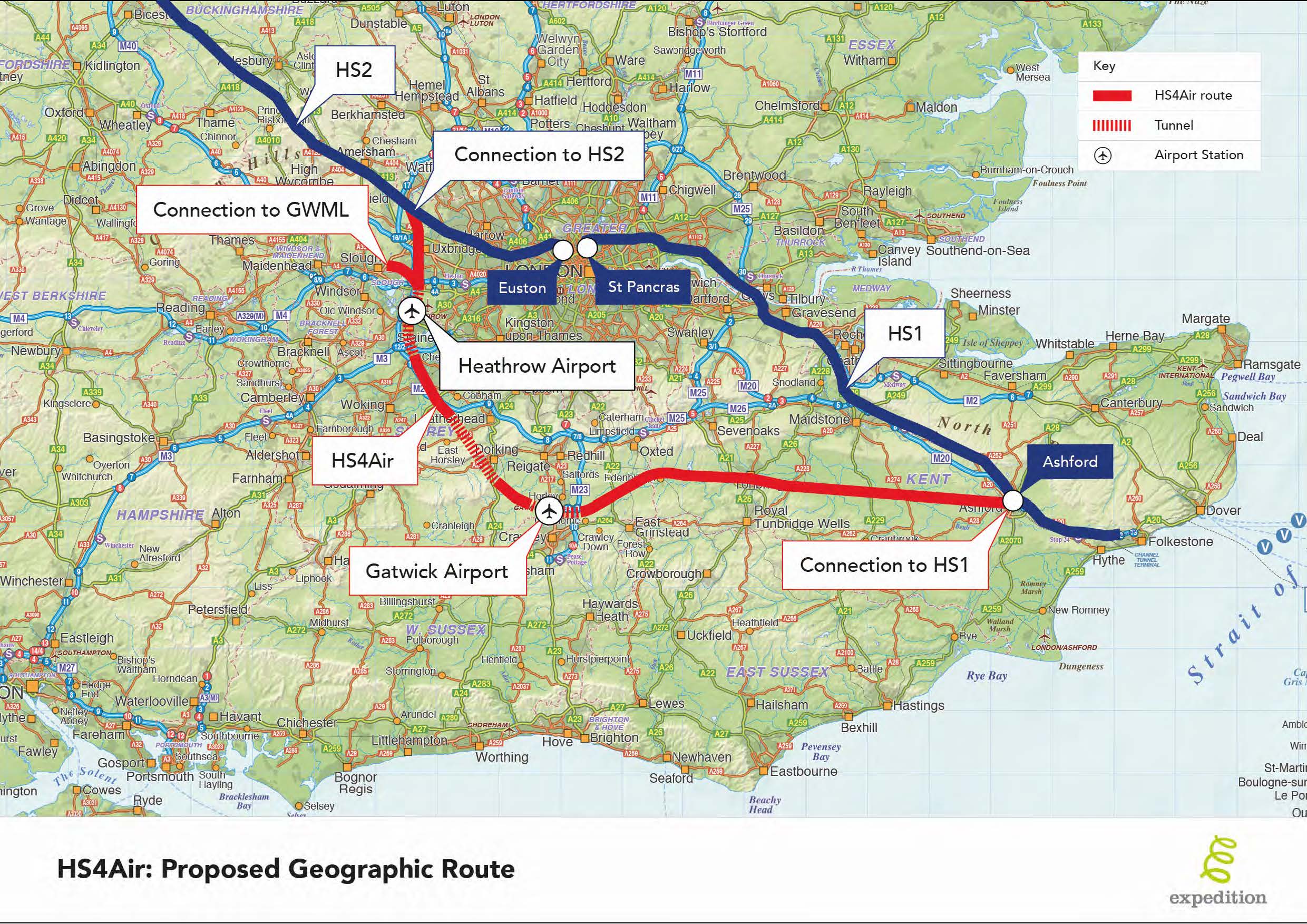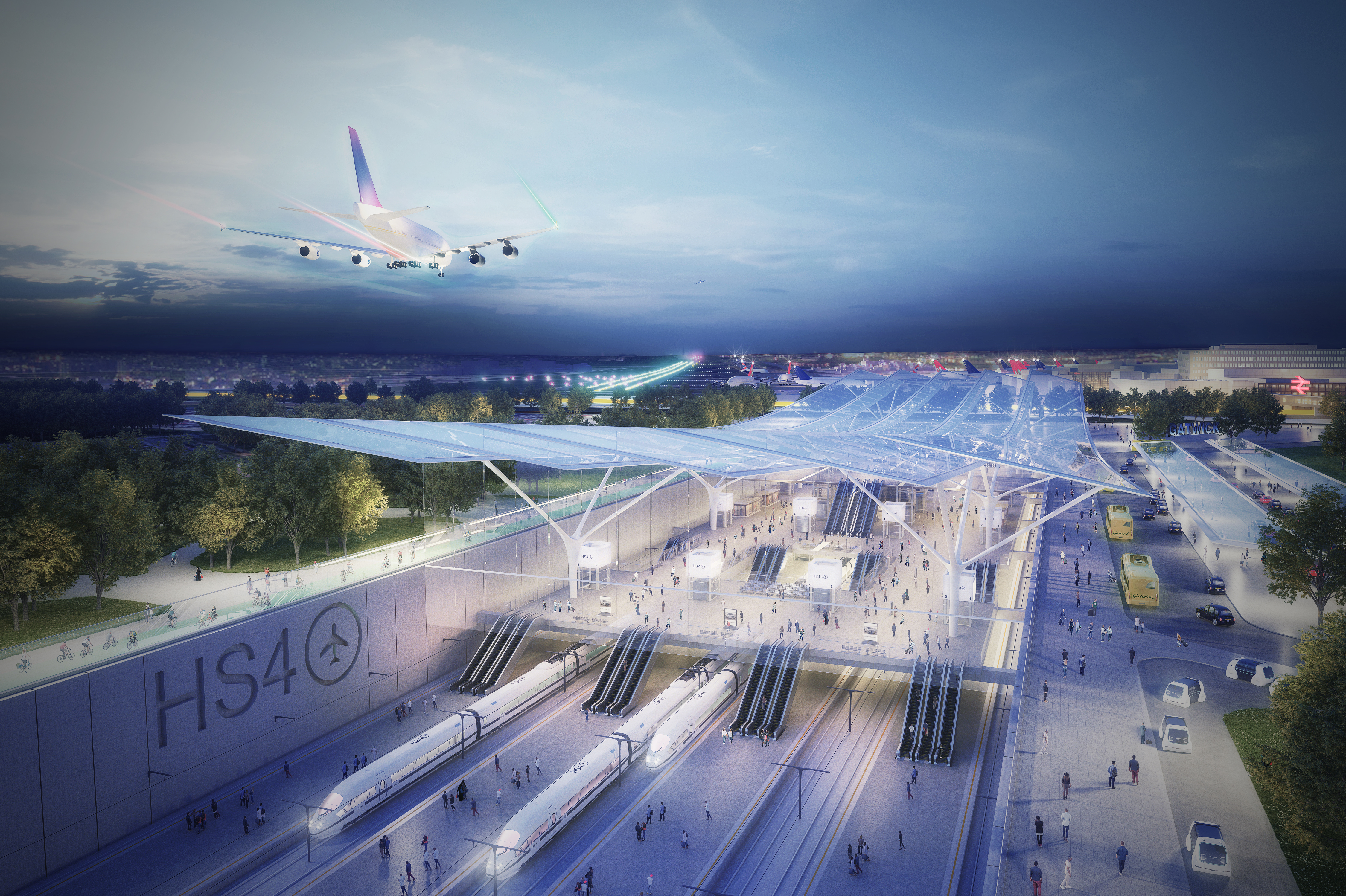News
Images Revealed: Proposed HS4Air will create new transport hubs boosting regional economies and slash journey times beyond London
A new image has been revealed for HS4Air, the proposal for a new high-speed railway around London that passes via both Gatwick and Heathrow Airports.
The proposal will be submitted to the Department for Transport in response to a call for ideas within the rail sector. The proposal will also have an important role for stimulating much-needed new housing developments in the South East over the coming decades.
HS4Air has been developed by London-based Expedition Engineering together with architects Weston Williamson + Partners (WW+P) and planning and development consultants Turley.
The proposed new railway, estimated to cost £10bn, is proposed to connect HS1 at Ashford to HS2 North West of London via Heathrow and Gatwick airports with a spur connection to the Great Western Main Line. Dubbed the “M25 for high-speed trains”, HS4Air would allow train journey times to be slashed from the UK’s two most important airports together with their hinterlands in South East England to the Midlands, North England and South Wales.
HS4Air will reduce journey times as follows:
- Ashford to Gatwick: 25 minutes (typically 1 hour 50 mins today)
- Manchester to Heathrow: 1 hour 10 mins (typically 3 hours 20 mins today)
- Heathrow to Gatwick: 15 minutes
- Cardiff to Heathrow: 1 hour 40 mins (typically 2 hours 50 mins today)
- Birmingham to Paris: 3 hours (typically 3 hours 50 minutes by air)
Four new stations along HS4Air at Ashford, Tonbridge, Gatwick and Heathrow will provide important new points of new transport connectivity to the rest of the UK beyond London. Both Heathrow and Gatwick airports will become multi-modal regional transport hubs with many passengers using these stations even if they are not catching a plane. The new connectivity created by the proposed high-speed line and the transport hubs along it are expected to act as a boost for regional economies from South East England to northern England.
HS4Air will remove London as the historic barrier for railway connectivity between UK regions North and West of London and continental Europe. By providing a fast “bypass” rail route around London, fast direct passenger and freight trains from the Midlands and North England to Europe can be made. City centre to city centre journey times from both Birmingham and Manchester to Paris will be faster using HS4Air than travelling by air. As a result, HS4Air will become a catalyst for economic activity between the UK regions and Europe.
By taking the people and freight out of London that does not need or want to pass through the congested metropolis, HS4Air is expected to release capacity on the London rail network back for use by the intra-London market.
How the line works
HS4Air connects the existing HS1 rail line to the Channel Tunnel to the planned HS2 rail line from London to Birmingham along a route that passes through Gatwick (LGW) and Heathrow (LHR) airports to the south and west of London. HS4Air also includes a connection to the Great Western Main Line railway (GWML) to allow new connectivity with South Wales and the West of England. The connectivity achieved by HS4Air will create a joined-up high-speed railway network across the UK and provide fast nationwide direct rail access to the country’s most important airports.

Image by Weston Williamson + Partners/Expedition
The length of the new HS4Air railway extends 140km between its connections with HS1 at Ashford and with HS2 near Denham, North West of London.
About 40 percent of the HS4Air line is created by the adoption of an existing Network Rail railway between Tonbridge and Ashford which, being flat and straight, can readily be upgraded for use by for high speed trains.
A significant part of the HS4Air project is that it will allow the introduction of a fast shuttle service between Gatwick and Heathrow airports with a 15-minute transfer time. This connectivity will mean that, from a user viewpoint, the two airports will effectively become one airport and mean that both airports will have substantially improved capacity and resilience in terms of their surface transport access.
To minimise its impact on environmentally sensitive areas such as the Surrey Hills (Area of Outstanding Natural Beauty) or to pass under built up areas around the airports, about 20 per cent of the railway will run in tunnels. To the West of London, HS4Air will run alongside the M25, to make use of an existing transport corridor.
Stronger transport links between the towns and cities in South East England and the rest of the UK (avoiding London) will stimulate regional economic growth across the country and contribute to the aims of the Governments Industrial Strategy to reduce the productivity gap across the country. HS4Air provides high speed rail connectivity that will stimulate new communities along and adjacent to it. Tens of thousands of new homes could be expected at locations such as the Medway Valley, Ashford and along the M3 corridor. It will also align with existing government housing proposals by creating investor confidence and supporting sustainable transport solutions.

Image by Weston Williamson + Partners/Expedition
Expedition director Alistair Lenczner said:
“As a joined-up, strategically important piece of infrastructure, HS4Air offers new connectivity that will provide an economic boost for the entire country. The multi-benefit nature of the project means that its will offer a better return on infrastructure investment than is often the case for infrastructure projects that have only a single primary objective.
HS4Air will overcome the barrier that historic London represents in terms of rail connectivity between the UK regions and Europe. By allowing London to be bypassed at high speed, economic activity between the UK regions and Europe can expect to grow.
The very positive response the HS4Air project has received from various parties suggests that the proposal can expect widespread public support as it moves forward”.
WW+P associate partner Nick McGough said:
“HS4Air takes the problem of linking HS1 with HS2 and turns it into an opportunity in by-passing London entirely whilst better connecting the UK’s two largest airports and the country generally through high speed rail. This generates huge regeneration potential and much wider economic benefits for the whole country.
It is exciting that the DfT’s Rail Market Led Proposal initiative opens the door for this sort of innovative proposal. HS4Air can help unlock opportunities for much needed housing in the South East through joined-up and sustainable infrastructure development.”
Director of Economics at Turley, Amy Gilham said:
“The HS4Air proposal ties in with many of the UK Government’s economic growth objectives. By reducing journey times by rail the line will help to deliver the Government’s main ambition of its Modern Industrial Strategy – to reduce the productivity gap across the country. It will also help to deliver much needed housing and employment growth in areas of recognised pressure, particularly the South East, by opening up sites and creating opportunities for sustainable development”.
Jo James, Chief Executive of Kent Invicta Chamber of Commerce, said:
“As a nation we need to be bold and think big. HS4Air proposal is the sort of forward thinking infrastructure project which could underpin the region’s future growth. Improving the rail connectivity between Kent and Gatwick, Heathrow and the rest of the country, would undoubtedly be a big boost for the economy of Kent, and the South East of England.”
20 July 2018